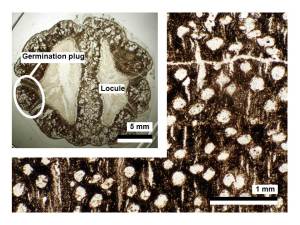
UF 00621-59109, the holotype of Oreomunnea grahamii. The specimen is shown in a lateral view (A), an apical view (B), and in cross section (C). Figure modified from Herrera et al. 2014.
For this week’s Fossil Friday post, I would like to show you a fossilized fruit called Oreomunnea grahamii. It was found in 2007 at the Lirio East locality of the Cucaracha Formation and is Early Miocene in age. This fruit belongs to the Family Juglandaceae, which is commonly known as the walnut family of trees. Before the discovery of this fossil fruit, the occurrence of the modern Neotropical genus Oreomunnea was mostly restricted to the microfossil record in the form of pollen.
To learn more about this fossil fruit discovery, download the publication by clicking here.
References:
Herrera, F., Manchester, S. R., Koll, R., and Jaramillo, C. 2014. Fruits of Oreomunnea (Juglandaceae) in the early Miocene of Panama. Pages 124-133 in W. D. Stevens, O. M. Montiel, and P. Raven, editors. Paleobotany and Biogeography: A Festschrift for Alan Graham in His 80th Year. Missouri Botanical Garden Press, St Louis, MO.

